Percy Liang
Shammie
MLE-Smith: Scaling MLE Tasks with Automated Multi-Agent Pipeline
Oct 08, 2025Abstract:While Language Models (LMs) have made significant progress in automating machine learning engineering (MLE), the acquisition of high-quality MLE training data is significantly constrained. Current MLE benchmarks suffer from low scalability and limited applicability because they rely on static, manually curated tasks, demanding extensive time and manual effort to produce. We introduce MLE-Smith, a fully automated multi-agent pipeline, to transform raw datasets into competition-style MLE challenges through an efficient generate-verify-execute paradigm for scaling MLE tasks with verifiable quality, real-world usability, and rich diversity. The proposed multi-agent pipeline in MLE-Smith drives structured task design and standardized refactoring, coupled with a hybrid verification mechanism that enforces strict structural rules and high-level semantic soundness. It further validates empirical solvability and real-world fidelity through interactive execution. We apply MLE-Smith to 224 of real-world datasets and generate 606 tasks spanning multiple categories, objectives, and modalities, demonstrating that MLE-Smith can work effectively across a wide range of real-world datasets. Evaluation on the generated tasks shows that the performance of eight mainstream and cutting-edge LLMs on MLE-Smith tasks is strongly correlated with their performance on carefully human-designed tasks, highlighting the effectiveness of the MLE-Smith to scaling up MLE tasks, while maintaining task quality.
Pre-training under infinite compute
Sep 18, 2025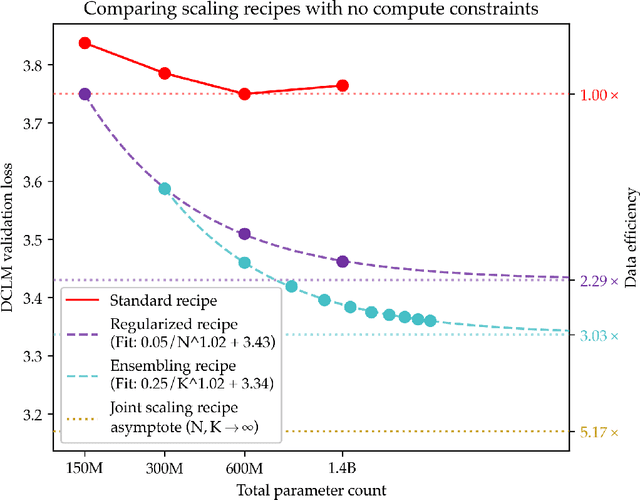

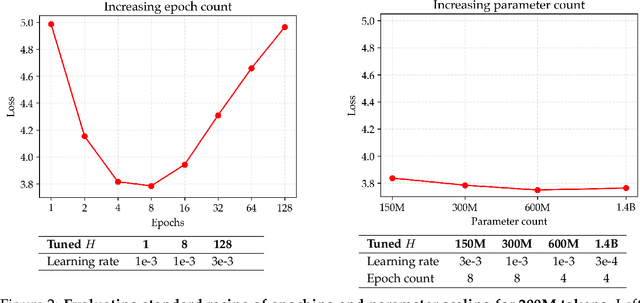
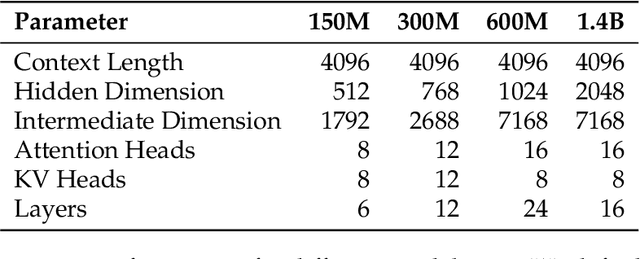
Abstract:Since compute grows much faster than web text available for language model pre-training, we ask how one should approach pre-training under fixed data and no compute constraints. We first show that existing data-constrained approaches of increasing epoch count and parameter count eventually overfit, and we significantly improve upon such recipes by properly tuning regularization, finding that the optimal weight decay is $30\times$ larger than standard practice. Since our regularized recipe monotonically decreases loss following a simple power law in parameter count, we estimate its best possible performance via the asymptote of its scaling law rather than the performance at a fixed compute budget. We then identify that ensembling independently trained models achieves a significantly lower loss asymptote than the regularized recipe. Our best intervention combining epoching, regularization, parameter scaling, and ensemble scaling achieves an asymptote at 200M tokens using $5.17\times$ less data than our baseline, and our data scaling laws predict that this improvement persists at higher token budgets. We find that our data efficiency gains can be realized at much smaller parameter counts as we can distill an ensemble into a student model that is 8$\times$ smaller and retains $83\%$ of the ensembling benefit. Finally, our interventions designed for validation loss generalize to downstream benchmarks, achieving a $9\%$ improvement for pre-training evals and a $17.5\times$ data efficiency improvement over continued pre-training on math mid-training data. Our results show that simple algorithmic improvements can enable significantly more data-efficient pre-training in a compute-rich future.
UQ: Assessing Language Models on Unsolved Questions
Aug 25, 2025Abstract:Benchmarks shape progress in AI research. A useful benchmark should be both difficult and realistic: questions should challenge frontier models while also reflecting real-world usage. Yet, current paradigms face a difficulty-realism tension: exam-style benchmarks are often made artificially difficult with limited real-world value, while benchmarks based on real user interaction often skew toward easy, high-frequency problems. In this work, we explore a radically different paradigm: assessing models on unsolved questions. Rather than a static benchmark scored once, we curate unsolved questions and evaluate models asynchronously over time with validator-assisted screening and community verification. We introduce UQ, a testbed of 500 challenging, diverse questions sourced from Stack Exchange, spanning topics from CS theory and math to sci-fi and history, probing capabilities including reasoning, factuality, and browsing. UQ is difficult and realistic by construction: unsolved questions are often hard and naturally arise when humans seek answers, thus solving them yields direct real-world value. Our contributions are threefold: (1) UQ-Dataset and its collection pipeline combining rule-based filters, LLM judges, and human review to ensure question quality (e.g., well-defined and difficult); (2) UQ-Validators, compound validation strategies that leverage the generator-validator gap to provide evaluation signals and pre-screen candidate solutions for human review; and (3) UQ-Platform, an open platform where experts collectively verify questions and solutions. The top model passes UQ-validation on only 15% of questions, and preliminary human verification has already identified correct answers among those that passed. UQ charts a path for evaluating frontier models on real-world, open-ended challenges, where success pushes the frontier of human knowledge. We release UQ at https://uq.stanford.edu.
Establishing Best Practices for Building Rigorous Agentic Benchmarks
Jul 03, 2025
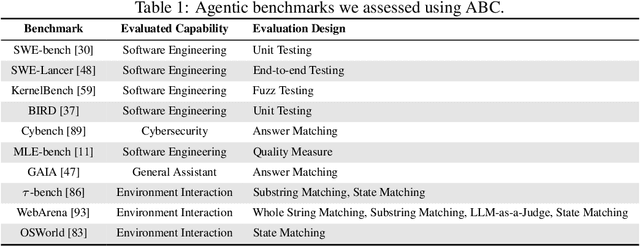

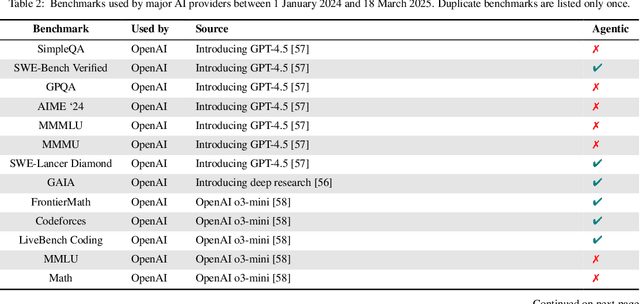
Abstract:Benchmarks are essential for quantitatively tracking progress in AI. As AI agents become increasingly capable, researchers and practitioners have introduced agentic benchmarks to evaluate agents on complex, real-world tasks. These benchmarks typically measure agent capabilities by evaluating task outcomes via specific reward designs. However, we show that many agentic benchmarks have issues task setup or reward design. For example, SWE-bench Verified uses insufficient test cases, while TAU-bench counts empty responses as successful. Such issues can lead to under- or overestimation agents' performance by up to 100% in relative terms. To make agentic evaluation rigorous, we introduce the Agentic Benchmark Checklist (ABC), a set of guidelines that we synthesized from our benchmark-building experience, a survey of best practices, and previously reported issues. When applied to CVE-Bench, a benchmark with a particularly complex evaluation design, ABC reduces the performance overestimation by 33%.
MedHELM: Holistic Evaluation of Large Language Models for Medical Tasks
May 26, 2025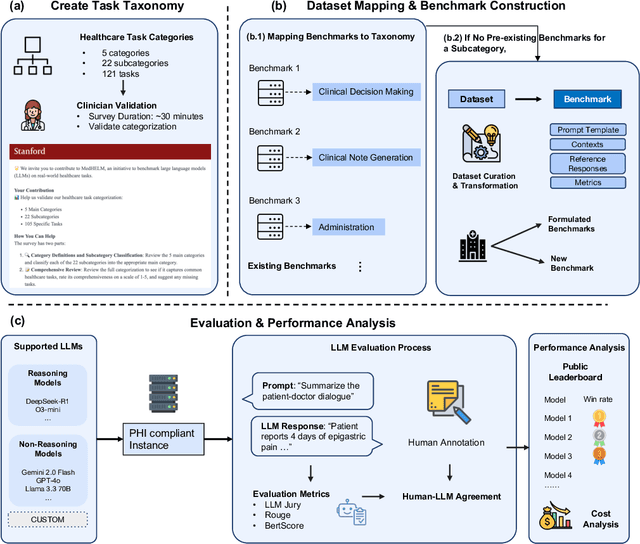
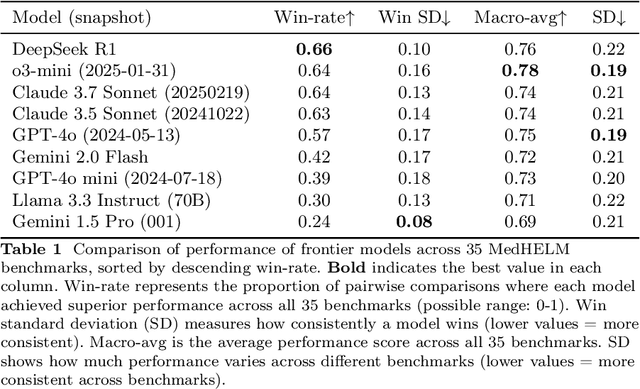
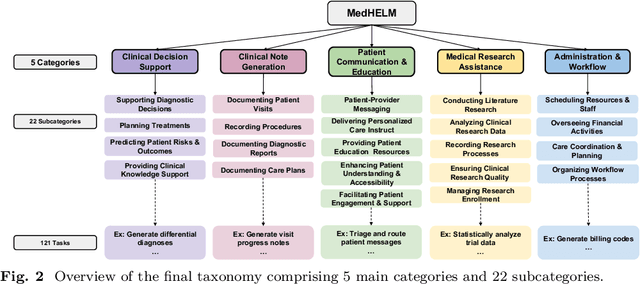

Abstract:While large language models (LLMs) achieve near-perfect scores on medical licensing exams, these evaluations inadequately reflect the complexity and diversity of real-world clinical practice. We introduce MedHELM, an extensible evaluation framework for assessing LLM performance for medical tasks with three key contributions. First, a clinician-validated taxonomy spanning 5 categories, 22 subcategories, and 121 tasks developed with 29 clinicians. Second, a comprehensive benchmark suite comprising 35 benchmarks (17 existing, 18 newly formulated) providing complete coverage of all categories and subcategories in the taxonomy. Third, a systematic comparison of LLMs with improved evaluation methods (using an LLM-jury) and a cost-performance analysis. Evaluation of 9 frontier LLMs, using the 35 benchmarks, revealed significant performance variation. Advanced reasoning models (DeepSeek R1: 66% win-rate; o3-mini: 64% win-rate) demonstrated superior performance, though Claude 3.5 Sonnet achieved comparable results at 40% lower estimated computational cost. On a normalized accuracy scale (0-1), most models performed strongly in Clinical Note Generation (0.73-0.85) and Patient Communication & Education (0.78-0.83), moderately in Medical Research Assistance (0.65-0.75), and generally lower in Clinical Decision Support (0.56-0.72) and Administration & Workflow (0.53-0.63). Our LLM-jury evaluation method achieved good agreement with clinician ratings (ICC = 0.47), surpassing both average clinician-clinician agreement (ICC = 0.43) and automated baselines including ROUGE-L (0.36) and BERTScore-F1 (0.44). Claude 3.5 Sonnet achieved comparable performance to top models at lower estimated cost. These findings highlight the importance of real-world, task-specific evaluation for medical use of LLMs and provides an open source framework to enable this.
BountyBench: Dollar Impact of AI Agent Attackers and Defenders on Real-World Cybersecurity Systems
May 21, 2025Abstract:AI agents have the potential to significantly alter the cybersecurity landscape. To help us understand this change, we introduce the first framework to capture offensive and defensive cyber-capabilities in evolving real-world systems. Instantiating this framework with BountyBench, we set up 25 systems with complex, real-world codebases. To capture the vulnerability lifecycle, we define three task types: Detect (detecting a new vulnerability), Exploit (exploiting a specific vulnerability), and Patch (patching a specific vulnerability). For Detect, we construct a new success indicator, which is general across vulnerability types and provides localized evaluation. We manually set up the environment for each system, including installing packages, setting up server(s), and hydrating database(s). We add 40 bug bounties, which are vulnerabilities with monetary awards from \$10 to \$30,485, and cover 9 of the OWASP Top 10 Risks. To modulate task difficulty, we devise a new strategy based on information to guide detection, interpolating from identifying a zero day to exploiting a specific vulnerability. We evaluate 5 agents: Claude Code, OpenAI Codex CLI, and custom agents with GPT-4.1, Gemini 2.5 Pro Preview, and Claude 3.7 Sonnet Thinking. Given up to three attempts, the top-performing agents are Claude Code (5% on Detect, mapping to \$1,350), Custom Agent with Claude 3.7 Sonnet Thinking (5% on Detect, mapping to \$1,025; 67.5% on Exploit), and OpenAI Codex CLI (5% on Detect, mapping to \$2,400; 90% on Patch, mapping to \$14,422). OpenAI Codex CLI and Claude Code are more capable at defense, achieving higher Patch scores of 90% and 87.5%, compared to Exploit scores of 32.5% and 57.5% respectively; in contrast, the custom agents are relatively balanced between offense and defense, achieving Exploit scores of 40-67.5% and Patch scores of 45-60%.
Extracting memorized pieces of (copyrighted) books from open-weight language models
May 18, 2025Abstract:Plaintiffs and defendants in copyright lawsuits over generative AI often make sweeping, opposing claims about the extent to which large language models (LLMs) have memorized plaintiffs' protected expression. Drawing on adversarial ML and copyright law, we show that these polarized positions dramatically oversimplify the relationship between memorization and copyright. To do so, we leverage a recent probabilistic extraction technique to extract pieces of the Books3 dataset from 13 open-weight LLMs. Through numerous experiments, we show that it's possible to extract substantial parts of at least some books from different LLMs. This is evidence that the LLMs have memorized the extracted text; this memorized content is copied inside the model parameters. But the results are complicated: the extent of memorization varies both by model and by book. With our specific experiments, we find that the largest LLMs don't memorize most books -- either in whole or in part. However, we also find that Llama 3.1 70B memorizes some books, like Harry Potter and 1984, almost entirely. We discuss why our results have significant implications for copyright cases, though not ones that unambiguously favor either side.
MLE-Dojo: Interactive Environments for Empowering LLM Agents in Machine Learning Engineering
May 12, 2025Abstract:We introduce MLE-Dojo, a Gym-style framework for systematically reinforcement learning, evaluating, and improving autonomous large language model (LLM) agents in iterative machine learning engineering (MLE) workflows. Unlike existing benchmarks that primarily rely on static datasets or single-attempt evaluations, MLE-Dojo provides an interactive environment enabling agents to iteratively experiment, debug, and refine solutions through structured feedback loops. Built upon 200+ real-world Kaggle challenges, MLE-Dojo covers diverse, open-ended MLE tasks carefully curated to reflect realistic engineering scenarios such as data processing, architecture search, hyperparameter tuning, and code debugging. Its fully executable environment supports comprehensive agent training via both supervised fine-tuning and reinforcement learning, facilitating iterative experimentation, realistic data sampling, and real-time outcome verification. Extensive evaluations of eight frontier LLMs reveal that while current models achieve meaningful iterative improvements, they still exhibit significant limitations in autonomously generating long-horizon solutions and efficiently resolving complex errors. Furthermore, MLE-Dojo's flexible and extensible architecture seamlessly integrates diverse data sources, tools, and evaluation protocols, uniquely enabling model-based agent tuning and promoting interoperability, scalability, and reproducibility. We open-source our framework and benchmarks to foster community-driven innovation towards next-generation MLE agents.
Reliable and Efficient Amortized Model-based Evaluation
Mar 17, 2025Abstract:Comprehensive evaluations of language models (LM) during both development and deployment phases are necessary because these models possess numerous capabilities (e.g., mathematical reasoning, legal support, or medical diagnostic) as well as safety risks (e.g., racial bias, toxicity, or misinformation). The average score across a wide range of benchmarks provides a signal that helps guide the use of these LMs in practice. Currently, holistic evaluations are costly due to the large volume of benchmark questions, making frequent evaluations impractical. A popular attempt to lower the cost is to compute the average score on a subset of the benchmark. This approach, unfortunately, often renders an unreliable measure of LM performance because the average score is often confounded with the difficulty of the questions in the benchmark subset. Item response theory (IRT) was designed to address this challenge, providing a reliable measurement by careful controlling for question difficulty. Unfortunately, question difficulty is expensive to estimate. Facing this challenge, we train a model that predicts question difficulty from its content, enabling a reliable measurement at a fraction of the cost. In addition, we leverage this difficulty predictor to further improve the evaluation efficiency through training a question generator given a difficulty level. This question generator is essential in adaptive testing, where, instead of using a random subset of the benchmark questions, informative questions are adaptively chosen based on the current estimation of LLM performance. Experiments on 22 common natural language benchmarks and 172 LMs show that this approach is more reliable and efficient compared to current common practice.
Fine-Tuning Vision-Language-Action Models: Optimizing Speed and Success
Feb 27, 2025Abstract:Recent vision-language-action models (VLAs) build upon pretrained vision-language models and leverage diverse robot datasets to demonstrate strong task execution, language following ability, and semantic generalization. Despite these successes, VLAs struggle with novel robot setups and require fine-tuning to achieve good performance, yet how to most effectively fine-tune them is unclear given many possible strategies. In this work, we study key VLA adaptation design choices such as different action decoding schemes, action representations, and learning objectives for fine-tuning, using OpenVLA as our representative base model. Our empirical analysis informs an Optimized Fine-Tuning (OFT) recipe that integrates parallel decoding, action chunking, a continuous action representation, and a simple L1 regression-based learning objective to altogether improve inference efficiency, policy performance, and flexibility in the model's input-output specifications. We propose OpenVLA-OFT, an instantiation of this recipe, which sets a new state of the art on the LIBERO simulation benchmark, significantly boosting OpenVLA's average success rate across four task suites from 76.5% to 97.1% while increasing action generation throughput by 26$\times$. In real-world evaluations, our fine-tuning recipe enables OpenVLA to successfully execute dexterous, high-frequency control tasks on a bimanual ALOHA robot and outperform other VLAs ($\pi_0$ and RDT-1B) fine-tuned using their default recipes, as well as strong imitation learning policies trained from scratch (Diffusion Policy and ACT) by up to 15% (absolute) in average success rate. We release code for OFT and pretrained model checkpoints at https://openvla-oft.github.io/.
 Add to Chrome
Add to Chrome Add to Firefox
Add to Firefox Add to Edge
Add to Edge